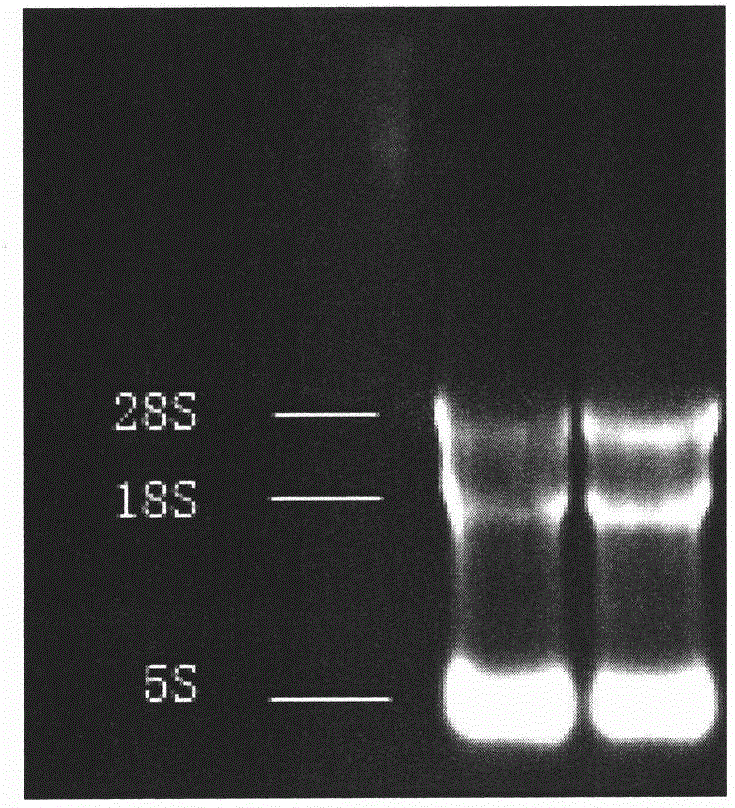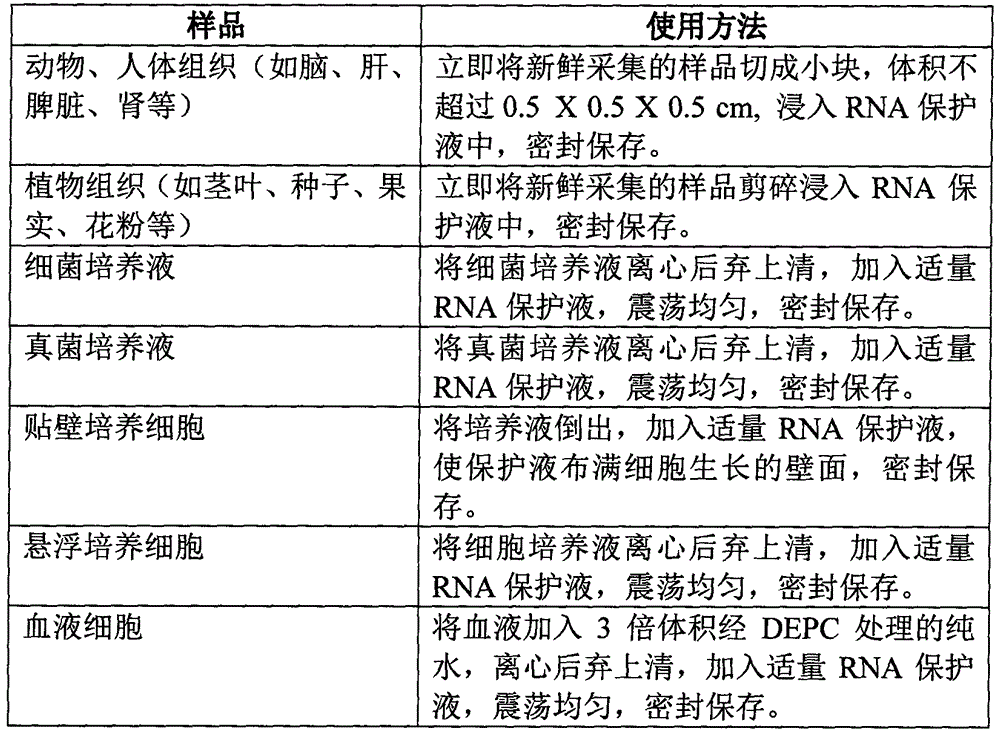A non-freezing type RNA protection solution
A protective liquid, non-freezing technology, applied in the field of biology, can solve the problem of not being able to store samples in a low temperature environment, and achieve the effects of simple and convenient sample transportation, safe and reliable experimental operation, and simple operation.
- Summary
- Abstract
- Description
- Claims
- Application Information
AI Technical Summary
Problems solved by technology
Method used
Image
Examples
Embodiment 1
[0029] Soak freshly dissected rat liver and kidney samples weighing about 200mg in 1mL RNA protection solution, place them in a sealed container at room temperature (25-35°C) for 14 days, take out the tissue, and remove the residual solution on the tissue with filter paper; Total RNA was extracted by Trizol method, and the integrity of RNA was identified by formaldehyde agarose denaturing gel electrophoresis.
[0030] The RNA extraction method is as follows: add 1 mL Trizol to 20 mg of tissue, fully homogenize with a disposable grinding rod, and after the sample is fully lysed, add 200 μL of chloroform, vibrate vigorously and mix well, then place at room temperature for 5 minutes to allow natural phase separation. Centrifuge at 12000r / min at 4°C for 10 minutes. The sample is divided into 3 layers, the yellow organic phase, the middle layer and the colorless aqueous phase. Transfer the aqueous phase to a new tube and add an equal volume of isopropyl alcohol that has been pre-coo...
Embodiment 2
[0043] Soak the freshly dissected rat liver weighing about 200 mg in 1 mL of RNA protection solution, place it sealed at room temperature (25-35° C.) for 7, 14, 28, and 42 days, and then extract total RNA using the Trizol method in Example 1. The dosage for each tissue extraction was 50 mg. After the extraction was completed, it was dissolved in 20 μL RNase-free water and stored at -80°C. After the last extraction was completed, the concentration and purity of the nucleic acid was detected by UV spectrophotometry. The test results are shown in Table 5. After the rat liver sample is immersed in the RNA protection solution of the present invention, when it is placed at room temperature for 14 days, the extracted RNA content has no significant difference compared with that of the fresh sample, and the RNA content decreases at 28 and 42 days.
[0044]Table 5: Purity and concentration of sample RNA at room temperature for different periods
[0045] Fresh 7 days 14 d...
Embodiment 3
[0048] Soak freshly collected samples of mulberry leaves, tomato leaves, and papaya leaves (about 200 mg each) in 1 mL of RNA protection solution, and place them sealed at room temperature (25-35°C) for 14 days. The purity of RNA was detected by spectrophotometry, and the detection results are shown in Table 6.
[0049] Grind the plant tissue thoroughly in liquid nitrogen, add 400 μL of the crushed tissue to a 2 mL centrifuge tube, and then add 1.2 mL of 65°C preheated extract (containing 50 mmol / L Tris-HCl pH 8.0; 10 mmol / L EDTA pH 8.0; 1mol / L NaCl: 2% SDS: 100mmol / L LiCl; 2% PVP40; 0.1% DEPC), shake and mix, add 600 μL of chloroform:isoamyl alcohol (24:1), shake and mix , centrifuge at 8000r / min at 4°C for 15 minutes, take the supernatant and add 400μL 8mol / L LiCl, mix well, precipitate at -20°C for 2h, centrifuge at 12000r / min at 4°C for 15 minutes, discard the supernatant, and wash with 500μL 0. 2M NaCl to dissolve the precipitate, add 500 μL of pre-cooled water-saturated...
PUM
 Login to View More
Login to View More Abstract
Description
Claims
Application Information
 Login to View More
Login to View More - R&D
- Intellectual Property
- Life Sciences
- Materials
- Tech Scout
- Unparalleled Data Quality
- Higher Quality Content
- 60% Fewer Hallucinations
Browse by: Latest US Patents, China's latest patents, Technical Efficacy Thesaurus, Application Domain, Technology Topic, Popular Technical Reports.
© 2025 PatSnap. All rights reserved.Legal|Privacy policy|Modern Slavery Act Transparency Statement|Sitemap|About US| Contact US: help@patsnap.com


